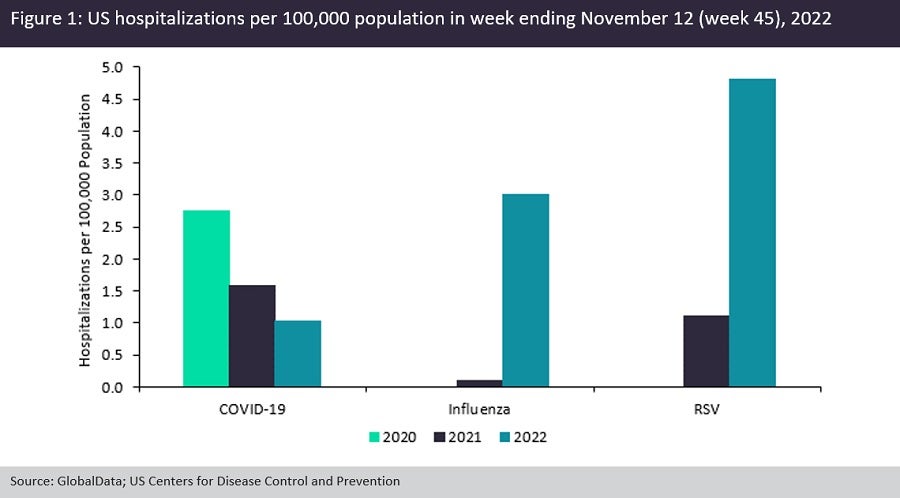In recent weeks, the US has seen a sharp increase in hospitalisations due to respiratory illness. The three agents in question are all viruses: seasonal influenza (flu), respiratory syncytial virus (RSV), and Covid-19. The uptick in cases and resulting hospitalisations this year has earned the triumvirate of illnesses the moniker of ‘tripledemic’.
The symptoms of Covid-19, flu and RSV heavily overlap; they include cough, congestion, runny nose, aches, fatigue and fever. This can cause difficulty in detecting cases without laboratory testing and can, therefore, lead to underreporting of each. Fortunately, transmission prevention measures such as handwashing and covering coughs are effective against all these viruses. At-risk populations can apply lessons learned from the Covid-19 pandemic and subsequent tripledemic to reduce the burden of these respiratory illnesses in future seasons.
The US Centres for Disease Control and Prevention (CDC) notes that almost all children will contract RSV by the age of two years, but in premature infants or infants aged under six months, it is particularly dangerous. In most seasons, 2% of affected children under six months require hospitalisation. Because of this, the CDC maintains the Respiratory Syncytial Virus Hospitalisation Surveillance Network (RSV-NET).
The RSV-NET reports that in week 45 of this year, the week ending 12 November, there were 4.8 RSV hospitalisations in every 100,000 of the population. This is a stark increase in hospitalizations from previous seasons. Week 45 of 2021 saw only 1.1 hospitalisations in every 100,000, and there were 0.0 hospitalisations until May in the 2020–21 season (Figure 1). The CDC notes that this may be an underestimation, as not all patients hospitalised with respiratory illness are tested for RSV. RSV also heavily impacts pregnancies and often results in preterm birth and infant death. GlobalData epidemiologists predict 417,629 preterm (<37 weeks) births and 17,319 preterm (<37 weeks) infant deaths by the end of 2022. This figure may be affected due to the unprecedented RSV spike this year.
Pregnant people and children under two years old are also at high risk of severe flu illness. They are joined by adults aged over 65 years and people with chronic health conditions such as chronic obstructive pulmonary disease (COPD), diabetes, or organ dysfunction. In recent flu seasons, 90% of hospitalised patients had a chronic health condition. The CDC’s Influenza Hospitalisation Surveillance Network (FluSurv-NET) reported three hospitalised flu cases in every 100,000 of the population in week 45 of this year. In comparison, flu hospitalisations in every 100,000 for the same week of last year and 2020 were 0.1 and 0.0, respectively (Figure 1). If continued, this peak puts the 2022–23 flu season on track to outpace hospitalisations as far back as the 2010–11 season. GlobalData epidemiologists predict 1.03 million laboratory-confirmed hospitalised cases by the end of the 2022 season, which is likely to be surpassed considering the unusually high burden seen this year so far.
Similar to flu, persons at high risk of severe illness due to Covid-19 are those who are pregnant, those aged over 65 years, and those with chronic health conditions. Fortunately, these populations are eligible for vaccination and antiviral treatments. Hospitalisation rates of Covid-19 were lower this year than in the previous seasons. As reported by the CDC’s Covid Data Tracker, week 45 of this year saw only 1.02 hospitalisations in every 100,000 of the population, as against 1.59 last year and 2.76 in 2020 (Figure 1). GlobalData epidemiologists have predicted a rolling average of 22,169 daily hospital occupancies on 12 November, dramatically reduced from 151,750 occupancies on 20 January of this year. Despite this improvement, Covid-19 hospitalizations compound with the unusually high flu and RSV hospitalisations, and the result is high stress on hospital systems.
The recent Covid-19 pandemic yielded public health lessons and behavioural changes that proved effective in preventing transmission. As Covid-19 joins other seasonal illnesses such as RSV and flu, it may be useful to apply these prevention measures as part of a yearly routine. Data gleaned from the current season’s tripledemic and the resulting hospitalisation burden may be useful in preventing such a burden in future seasons.





